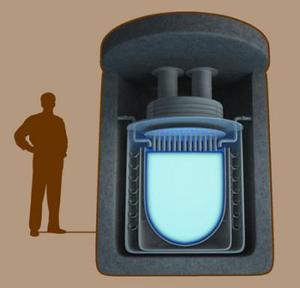Nuclear mattersThe day of transportable, refrigerator-size nuclear reactor nears
The need for more energy and the growing interest in energy not based on fossil material have led to a revival of interest in nuclear power; there is a competition afoot among several companies for designing and building — and receiving a operation license for — a refrigerator-size nuclear reactor; the $50 million, 25-megawatt unit is transportable by truck, and would put electricity into 20,000 homes

Artist's conception of a transportable nuclear reactor // Source: innovation-america.org
Manufacturers of refrigerator-sized nuclear reactors will seek approval from U.S. authorities within a year to help supply the world’s growing electricity demand. John Deal, chief executive officer of Hyperion Power Generation Inc., intends to apply for a license “within a year” for plants that would power a small factory or town too remote for traditional utility grid connections.
Jeremy van Loon and Alex Morales write in Bloomberg BusinessWeek that the Santa Fe, New Mexico-based company and Japan’s Toshiba Corp. are vying for a head start over reactor makers General Electric Co. and Areva SA in downsizing nuclear technology and aim to submit license applications in the next year to U.S. regulators. They are seeking to tap a market that has generated about $135 billion in pending orders for large nuclear plants.
“We’re building iPhones when the nuclear industry has traditionally built mainframe computers,” said Deal. Hyperion has more than 150 purchase commitments from customers such as mining and telecom companies, provided its technology gets licensed for operation, he said.
A generation after the Chernobyl and Three Mile Island accidents wiped reactor construction off the agenda of many governments, developers are pressing ahead with designs to satisfy demand for power that doesn’t pollute the skies. World electricity demand is likely to grow 2.7 percent a year from now until 2015 and then 2.4 percent annually until 2030, the International Energy Association estimates.
Price tag
Utility-scale reactors cost about $2.3 billion apiece and produce 1.2 gigawatts of power, Hyperion’s price tag is $50 million for a 25-megawatt reactor more comparable to a diesel generators or wind farms. Transportable by truck, the units would come in a sealed box and work around the clock, requiring less maintenance than a fossil fuel plant, the developers say. They would cost 15 percent less per megawatt of capacity than the average full-scale atomic reactors now in on the drawing board, according to World Nuclear Association data.
“A 25-megawatt plant would put electricity into 20,000 homes, and it would fit inside this room,” James Kohlhaas, vice president at a Lockheed Martin Corp. unit that builds power systems for remote military bases, said in an interview. “It’s a pretty elegant micro-grid solution.”
Van Loon and Morales note that certifying and building small reactors will require the same multi-year licensing procedure necessary for bigger plants. Since no small-scale systems are operating, there is no track record to know how well they will work.
Pandora’s Box
“Whether it’s
